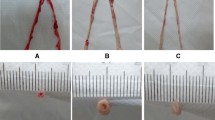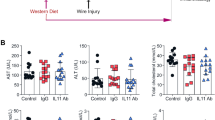Abstract
The inhibition of neointima formation by drugs is a major goal to prevent restenosis following angioplasty. In the present study, the effect of etofibrate on blood lipids and vessel wall was investigated using a balloon injury rat model. Two weeks after ballooning the common carotid artery neointima formation was quantified by morphometric measurement of the neointimal area and cellularity in vessel cross sections, and by fluorometric evaluation of the DNA content. Etofibrate (160 mg/kg/day) had no effect on plasma triglyceride levels, but reduced serum cholesterol by about 25%. The injury-induced increase of both the neointimal area and the DNA-content was significantly inhibited by 47% (P <0.005) and 34% (P <0.05), respectively, in the drug-treated animals in comparison to the untreated control rats. The ratio of neointima and media was significantly (P < 0.001) reduced from 152.9 ± 11.6% (controls) to 82.84 ± 12.59% in the etofibrate-treated group. The cellularity (numerical profile and volume density of nuclei) in the neointima was similar in both groups. In conclusion, injury-induced neointima formation is reduced in etofibrate-treated animals, which could be due to an inhibition of smooth muscle cell proliferation.
Similar content being viewed by others
References
Betz E, Quack G (1990) Effect of etofibrate on the development and the regression of atheromas in a rabbit model of atherosclerosis. Vasa 2: 157–160
Clowes AW, Reidy MA, Clowes MM (1983a) Mechanisms of stenosis after arterial injury. Lab Invest 49: 208–215
Clowes AW, Reidy MA, Clowes MM (1983b) Kinetics of cellular proliferation after arterial injury, I: Smooth muscle cell growth in the absence of endothelium. Lab Invest 49: 327–333
Ferns GAA, Raines EW, Sprugel KH, Motani AS, Reidy MA, Ross R (1991) Inhibtion of smooth muscle accumulation after angioplasty by an antibody to PDGF. Science 253: 1129–1132
Fujii S, Wüfroth P (1995) Inhibition of induction of type I plasminogen activator inhibtor by etofibrate. Circulation (in press)
Hopf N, Bremm J, Bohl J, Pernecky A (1994) Image analysis of proliferating cells in tumors of the human nervous system: an immunohistochemical study with the monoclonal antibody Ki-67. Neurosurgery 35: 917–923
Jonasson L, Holm J, Hansson GK (1988) Smooth muscle cells express Ia antigens during arterial response to injury. Lab Invest 58: 310–315
Klör E, Loy S, Huth K (1994) Effects of etofibrate therapy on high lipoprotein(a) levels in patients with hypercholesterolemia. Curr Ther Res 55: 988–996
Kranzhöfer R, Schirmer J, Schömig A, von Hodenberg E, Pestel E, Metz J, Lang HJ, Külbler W (1993) Suppression of neointimal thickening and smooth muscle cell proliferation after arterial injury in the rat by inhibitors of Na+-H+ exchange. Circ Res 73: 264–268
Krüger B, Thiemann R (1987) Hyperaggregability of platelets in patients with hyperlipoproteinemia type IIb under treatment with etofibrate retard and acetylsalicylic acid. In: Paoletti R, Kritchevsky D, Holmes W L (eds) Drugs affecting lipid metabolism. Springer, Berlin pp 389–393
Labarca C, Paigen KA (1980) A simple, rapid, and sensitive DNA assay procedure. Anal Biochem 102: 344–352
Leschke M, Strauer BE (1992) Therapy with fibrates. Significance for lipid-lowering treatment in patients with atherosclerosis. Münch Med Wochenschr 134: 744–748
Metz J, Schmelz A, Pavlov P (1990) Morphologische Untersuchungen zur Quantifzierung der Arteriosklerose. Z Gerontol 23: 140–142
Pagenstecher A, Dickmann P, Pill J, Hartig F, Metz J (1992) Arteriosklerose in Kaninchen nach Ballonierung der Aorta. In: Heinle H, Schulte H, Schäfer HE (eds) Diätetik und Arteriosklerose. Vieweg, pp 515–521
Polimeni PJ, Cunningham P, Otten MD, McCrea D (1987) Morphometric quantification of atherosclerotic plaques by computer-assisted image-analysis of histographs. Comp Biomed Res 20: 113–124
Series JJ, Gaslake MJ, Kilday C et al. (1988) Influence of etofibrate on low density lipoprotein metabolism. Atherosclerosis 69: 233–239
Spöttl F, Froschauer J (1976) Influence of etofibrate on plasma fibrinogen and plasminogen concentrations in patients with different forms of primary hyperlipoproteinemia. Atherosclerosis 25: 293–301
Steinberg D, Parthasarathy S, Carew TE, Khoo JC, Witztum JL (1989) Beyond cholesterol: modifications of low density lipoprotein that increase its atherogenicity. N Engl J Med 320: 915–924
Thornton MA, Gruentzig AR, Hollman J, King SB III, Douglas JS (1984) Coumadin and aspirin in prevention of recurrence after transluminal coronary angioplasty: a randomized study. Circulation 4: 721–727
Weibel ER (1979) Stereological methods, vol 1. Academic Press, New York
Whitworth HB, Roubin GS, Hollman J, Meier B, Leimgruber PP, Douglas JS Jr, King SB III, Gruentzig AR (1986) Effect of nifedipine on recurrent stenosis after percutaneous transluminal coronary angioplasty. J Am Coll Cardiol 8: 1271–1276
Wiilfroth P, Richter CM, Burkard M, Huth K, Quack G (1992) Etofibrate treatment alters low density lipoprotein susceptibility to lipid peroxidation. Drugs Exptl Clin Res XVIII 11/12: 469–474
Author information
Authors and Affiliations
Rights and permissions
About this article
Cite this article
Kinscherf, R., Metz, J. & Wülfroth, P. Etofibrate suppresses neointima formation of the ballooned common carotid artery of rats. Naunyn-Schmiedeberg's Arch Pharmacol 352, 424–428 (1995). https://doi.org/10.1007/BF00172780
Received:
Accepted:
Issue Date:
DOI: https://doi.org/10.1007/BF00172780




